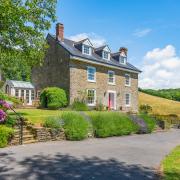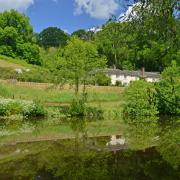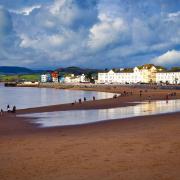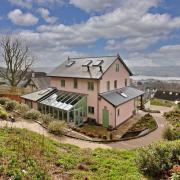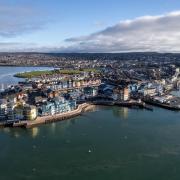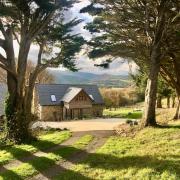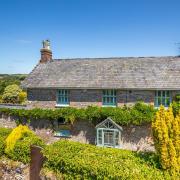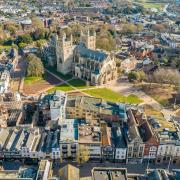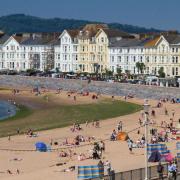The historic Devon town has a poetic history - and great modern day community spirit

Bright blue skies and glorious sunshine, the hustle and bustle of people going about their daily errands while over yonder, the mighty River Otter winds its way through the countryside. It’s enough to make anybody feel quite poetic.
In fact, poetry is very much part of the scenery here in Ottery St Mary. The town is the birthplace of the famous poet Samuel Taylor Coleridge, friend of William Wordsworth and a founder of the Romantic Movement in England.
“Look down by your feet on the path there,” says Roger Giles, longstanding Ottery town councillor and former mayor. “They are lines from Coleridge’s famous poem, Kubla Khan.”
The fact that you can read a great literary work along a pathway to the local playground says a lot about the importance of Ottery’s heritage and traditions to the people who live here. Why else would they charge through the streets carrying flaming barrels of tar? Yes, as well as Romantic poetry, Ottery St Mary is famous for its eye-poppingly bonkers ‘Tar Barrels’ ritual. For reasons lost in the myths of time, every 5 November, locals hoist lit barrels soaked in tar onto their backs and shoulders in front of thousands of delighted spectators.

It’s a well-organised, big deal of an event, backed by local businesses and enjoyed by residents and visitors year after year.
“I can’t remember a time in my life when there wasn’t any sort of occasion on 5 November,” says Roger, giving a sense of the town’s dejection at having to cancel the tar barrels for the first in time living memory because of coronavirus. “I remember going to it with my grandfather.”
We walk up Silver Street towards St Mary’s Church, deemed to be one of the most magnificent in the country and modelled on Exeter Cathedral. Next to it sits Chanter’s House, where Oliver Cromwell and Sir Thomas Fairfax are said to have visited in 1645 during the English Civil War. On the other side of town sits Raleigh House, once the site of a 16th century building where Sir Walter Raleigh lived and was later the home of Dr Edward Davy, pioneer of the electric telegraph.

READ MORE: 23 reasons to love Devon
Ottery’s residents might have missed out on their important November tradition last year but this town is about much more than hot tar barrels.
“It is steeped in history,” says Roger, as he takes me on a whistle-stop tour, taking in some of the many important buildings, plaques and monuments that can be found around every corner (there’s even a Japanese peace bell in Sainsbury’s car park to mark Ottery’s twinning with Otari in Japan).

We head up past St Mary’s Church, cross the road and stand outside The Priory, a grand Grade II-listed Georgian building now being converted into flats.
“Now, this used to be the King’s School and then the police station,” says Roger. “I remember the inside of it quite well,” he adds, explaining how as a young boy, he ended up being given a stern talking to by a local police officer after some children were caught throwing stones at windows.
“That telling off had the desired effect!” says Roger, 73, who is also part of Ottery’s heritage, in a sense. He’s lived here for 53 years and talks about his childhood memories, then about the pubs he used to visit in his youth (some of which are still here), his grandparents, his mother’s grandfather, Arthur Marshall, buried in the grounds of the United Reformed Church, said to be one of the oldest in the kingdom. Roger is clearly passionate about his hometown – but so are most of the locals.
Ian Chown, 34, grew up here then moved away to university before coming home four years ago. He now has a ten-month-old son, Arthur, and says Ottery is the perfect place for family life.

“It’s such a nice town and there is just this great community feel,” he says. “There are lots of events that keep our history alive and we’ve got loads of independent businesses. I think at one point, we did actually have a butcher, a baker and a candlestick maker!”
Proper useful local shops are in abundance here, as well as some interesting finds, such as the Samosa Lady in Mill Street and Otter Furniture in Broad Street. It’s easy to see why people don’t feel the need to venture far.
“Who could possibly wish to live anywhere else?” says Roger, as we stroll on to Otter Mill, once home to electrical firm Otter Mill Switchgear. The handsome looking building, now part of a very tasteful looking housing estate, is being restored and converted into residential homes. “There’s lots of great things going on here,” says Roger. “It’s not just about the past; we’re looking forward as well.”
We pass the local newsagents Pearson’s News where a lost and well-worn Bart Simpson toy has been prominently placed in the window with a note that reads: ‘Found in Mill Street’. I think about that note on the way home. It’s not as fancy as a Coleridge sonnet but it still says a lot about the spirit of this town.
See otterystmary.info; otterystmary-tc.gov.uk
THINGS TO KNOW ABOUT OTTERY ST MARY
1. Ottery St Mary stands on the eastern side of the River Otter, from which it takes its name.
2. The town is the birthplace of famous English poet Samuel Taylor Coleridge (21 October, 1772-25 July, 1834). Coleridge was also a literary critic and philosopher who, with his friend William Wordsworth, was a founder of the Romantic Movement in England and a member of the Lake Poets.
3. The Coleridge Memorial Trust recently ran a successful funding campaign to commission the creation of a Samuel Taylor Coleridge memorial statue, set to be built in the grounds of St Mary’s Church. The statue, by local sculptor Nicholas Dimbleby, will be the first life-size memorial of Coleridge anywhere in the world.
4. The Tumbling Weir is a circular weir that allows water from a leat or man-made stream to reach the River Otter.
5. There is a wealth of spectacularly attractive countryside between the ridges to the east (East Hill) and to the west (West Hill) of the town, with a huge number of bridleways and footpaths, perfect for a wintry walk.
6. Events in Ottery St Mary include Pixie Day in June, where children dress up as pixies and re-enact an old legend, capturing the bell-ringers and spiriting them away to their “cave”.
7. Cadhay is a historic house situated just outside Ottery. The Tudor manor house has magnificent gardens with medieval fishponds.
8. Licensed feasting house The Rusty Pig is a great place to enjoy seasonal food, sourced from small-scale local producers and growers, as much as possible.
9. Ottery is known to a generation of Harry Potter readers as Ottery St Catchpole. It’s thought JK Rowling – who studied at Exeter University - based her fictional wizarding town on Ottery St Mary.
10. Many of the street and place names have religious connotations, including Paternoster Row, Amen Corner and the Land of Canaan.
11. Find out more about Ottery’s rich history with a visit to the town’s Heritage Museum, situated in the Victorian Old Town Hall.
12. The Volunteer Inn (or the Volley, as it’s affectionately known) has been part of Ottery St Mary’s history since 1810 when it opened as a dwelling, hostelry and recruitment centre for the Napoleonic War. Today, it serves up great food, ales and a large dose of community atmosphere.
Join our Facebook group to keep up to date with the latest news, events and people in Devon





